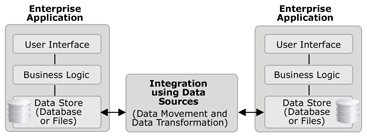Integration Using Data Sources
Integration Using Data Sources
Integration based on using data sources takes advantage of the data store and data movement as the point of integration. Applications must store information in some form of persistent data store. Most recent applications, including many of the packaged software products, use a relational database system for this persistent data store. Older host-based applications may use Virtual Sequential Access Management (VSAM) files for the data store. Desktop productivity applications may use Windows or Macintosh database systems such as Microsoft Access, Microsoft FoxPro, or FileMaker Pro. Information is often extracted automatically from one data source, modified and transformed as needed to comply with business rules, and copied to other databases.
The reality of this concept is a bit challenging. In order to use data integration successfully, the structure of the metadata maintained in the application databases needs to be well understood. The database schema and the meaning of various data fields that are affected must be known. A simple update operation may require changes to several databases and many different tables. Sometimes, a limited understanding of the underlying business logic is necessary in order to comprehend all of the data fields that are affected by an operation.
To its advantage, the data integration approach is often less costly than more intrusive EAI methods. The tools and technologies needed for moving data between databases are well established and inexpensive compared with other EAI methods. The relational database products used for the data store often include the necessary features to support data movement and transformation. Since the existing applications are spared changes, the costs associated with modifying application source code, testing, and redeployment are avoided.
The following figure shows an overview of integration using data sources.

Integration using data sources
| Previous Next |
EAN: 2147483647
Pages: 483